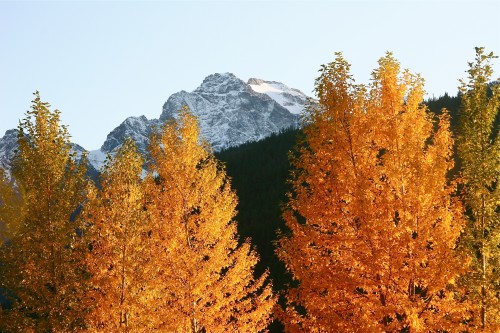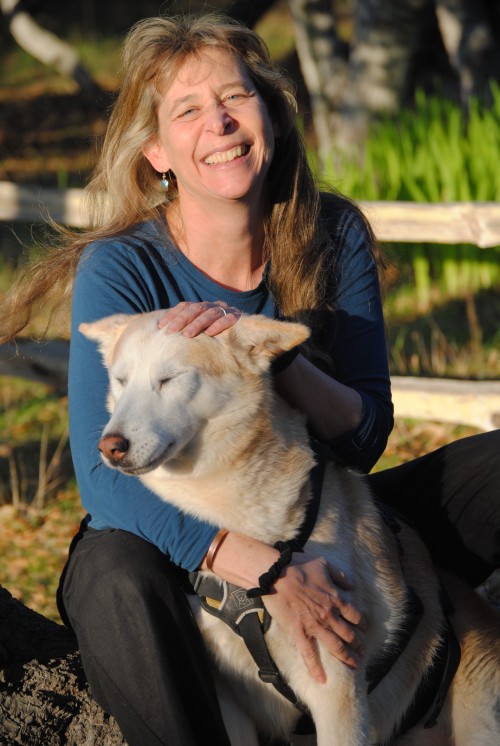Practice, Practice, Practice: Writing and Meditation in the North Cascades

By Holly Hughes
Editor’s note: Holly is co-leading the October 12-14 workshop “Sit, Walk, Write: Nature and the Practice of Presence” at the Learning Center — only a handful of spots are left!
I’m at the North Cascades Institute with my friend and co-teacher Kurt Hoelting to teach a weekend workshop called: Sit, Walk, Write: Nature and the Practice of Presence. We’re gathered together in the outdoor amphitheater to meet and welcome the forty-five participants, many of whom have driven many hours and miles to be here. The group is larger than we expected and I confess to feeling apprehensive about how it will work, sharing solitude –and the quiet beauty of this place– with so many people. But I also know the beauty of practicing together, of learning to trust each other in sharing silence, that our individual practice can be enriched and steadied by the sense of solidarity, the presence of the person next to you, breathing together, in and out.
As we go around the circle, introducing ourselves, my eye keeps drifting up to the alpenglow on the high peaks behind us. In this place, especially, I feel the presence not just of the other participants but of those writers who’ve come before us. As I look up at Sourdough Mountain, I can’t help but think of Gary Snyder and Philip Whalen, who spent several seasons high up in a fire lookout, Jack Kerouac across the way at Desolation Peak, and all the words written here, the practices these writers did in concert with this beautiful landscape.
I’m reminded that whenever we come together, we bring the presence not just of those who are with us, but of a much larger community: the books that have informed us, and the writers who’ve nudged us along, helping to shape our views.
By the second day, we’ve settled into a rhythm of sitting, walking and writing in silence, both inside our classroom and out in the fall sunlight streaming through the aspens and birches. Though our large circle reaches all four walls of the room, we’ve found that sitting in silence together makes it all work; what might feel crowded is beginning to feel more and more like rich community as we move back and forth between silence and sharing.
We hike up to the waterfall halfway up Sourdough Mountain, and each of the forty-five participants peels off the path to find his/her own “sit spot,” as Adam the naturalist called it, a place to sit in the silence of the fall woods, reflect, and write. As Adam comes down the path, he calls us all back with a raven call so authentic I peered into the tops of the Douglas firs and aspens, looking for the bird. We return, each from our own small island of leafy silence, to gather again in a circle and read aloud, our words shimmering between us like the last golden leaves of the aspens holding the late summer sun.
At the end of the last day, we each sit quietly in the dining room with tea, looking out over the lake, each with our journals, trying to capture this exquisite day in words, watching it slip away. Earlier, during one of our periods of meditation, I sat on a low, flat rock above the lake at the end of the log boom, noticing how the surface is agitated outside the log boom, serene within. It seems a perfect analogy for the last few days; we’ve seen how sitting, walking and writing in silence enables these ripples to smooth out, at least until the next disturbance comes along.
Tonight we’ll gather one last time together, each with our own disturbances, breathing in and out, following our breath until our minds are as serene as the glimmering blue surface of the lake. Kurt will ring the bell and we’ll drop down, slowly, into the shared silence that now feels as comfortable as an old sweatshirt, supporting each other in this practice, holding together and savoring the last golden minutes of this fleeting fall season. If we’re lucky, perhaps the spirits of Snyder, Kerouac and Whalen—and all the writers we admire—will join their words with ours.
Contemplation Practice
1. Reflect on what you practiced as a child. How did you feel about it? Was practice a word you dreaded or embraced? What do you practice today? Think about all the skills and habits of mind you practice each day—and how those practices make you who you are.
2. Find a friend or friends to practice sitting quietly together. You may already have your own meditation practice, but it helps to have a sangha—a community—even if it’s just a sangha of two. Set a regular time to practice together each week. It works best if you just set a time and others show up—no phone calls or emails—just a time that you agree to set aside each week to sit together.
Writing Practice
1. Try timed writing practice, alone or with others. You can use technical considerations—like the long sentence—or be more free-form, writing from random topics and start lines. Consider this a kind of “writing meditation,” not directing the work too much, allowing yourself to breathe. Natalie Goldberg, in Writing Down the Bones, describes simple timed writing practices you can do alone or with others. As you continue to practice this way, you will be able to “hit the ground running” whenever you sit down to write.
2. Find friends who are willing to hike or walk together in silence, then set aside 20 minutes to find a quiet place to sit alone. Just sit for the first 10 minutes, seeing, listening, smelling. Then write for 10 minutes about what you see. You can do this in a city park or out in the wilderness. Share your writings with each other.

Excerpt from Chapter 6: “Practice, Practice, Practice”
from The Pen and the Bell: Mindful Writing in a Busy World
published by Skinner House Books, May 2012
http://www.penandbell.com/

